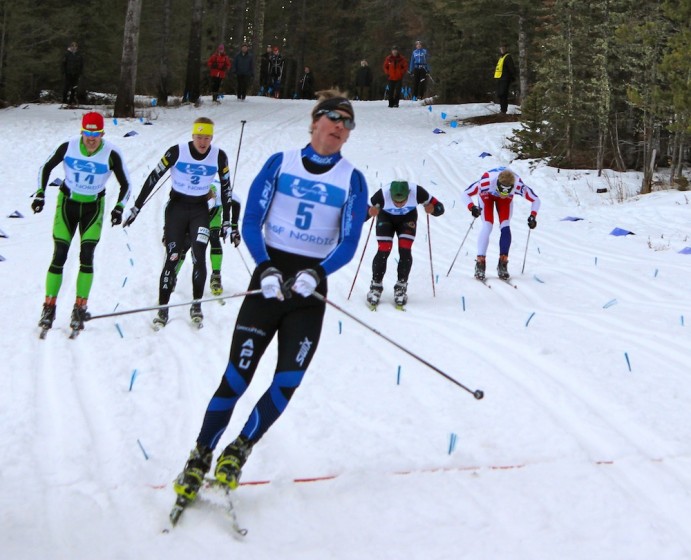
BOZEMAN, Mont. — When the stakes are high, breakout performances are inevitable. Knowing it could be his last chance to earn a trip to the biggest stage of his life, Reese Hanneman (Alaska Pacific University) pulled out his first career SuperTour win at Bohart Ranch on Saturday in the classic sprint, skiing a step ahead of the field to beat Nils Koos (Craftsbury Green Racing Project) and teammate Erik Bjornsen.
“I was confident I was capable of that,” Hanneman said. “Knowing that was probably my only shot [at the World Cup], the only thing I was thinking was, ‘You don’t want to finish and wish you’d done anything else, you just have to turn yourself inside out to try to get there first.’”
It may not be until Monday that Hanneman finds out if he’s made that team, but on Saturday he at least knew he couldn’t have done anything better. When the men’s final came out of the woods and entered the defining last 400 meters, he was already in the lead and gapping the field.
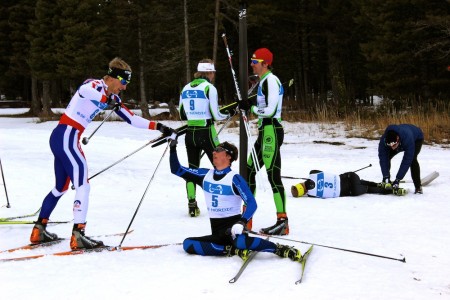
“I didn’t even feel like I surged, I just gave it everything I had and just slowly started to build a gap,” Hanneman said. “I mean, of course you’re super nervous in your head the whole way, you’re sure someone’s going to pass you. It’s just throttling it all the way in.”
But nobody could touch him, and as Hanneman neared the finish he turned to realize that the race was his.
“It was just sweet to see I had a little gap and it’s amazing to turn around and have a day like that,” he concluded.
Hanneman’s position at the front, at a point so far from the finish, surprised even his coach.
“It’s exceptional,” APU head coach Erik Flora said. “Both [Hanneman and Bjornsen] came out of the woods together in the lead. I kind of expected them to be mid pack but in the end they came out in front, and so to see them do that was really exciting.”
Eric Packer (SMS T2), who finished sixth, was impressed with Hanneman’s skiing.
“It was awesome to see Reese crush it today. He’s a really strong skier technically; I think we’ll see big things from him.”
Hanneman began the day in an unassuming fifth qualifying spot. He won his quarterfinal and slipped through in third in the semis. Dakota Blackhorse-von Jess drew first blood in the finals, taking the lead out of the stadium to stay out of trouble.
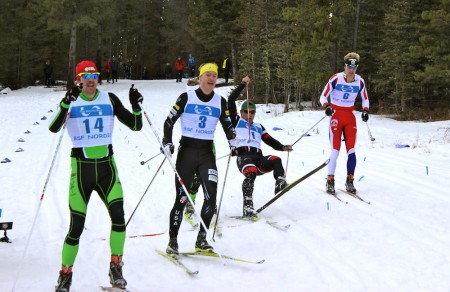
“The plan was to do as little work as possible,” Blackhorse-von Jess said. “It sort of worked. I was more in front than I wanted to be.”
He, Hanneman and Bjornsen came around the final turn together and things looked pretty even. When Blackhorse-von Jess was forced to swing into the far open finishing lane, he lost ground.
“Being in the best line is where you wanted to be, and I was not there and I just ran out of gas,” he said. “I think I was skiing a lot better than that, but I also very badly mistimed a lunge and ended up on my back instead. So that’s a podium to fifth place, which is too bad.”
Koons and Bjornsen hung on to make the podium in the lunge for second place.
“My goal was to push the pace on the back side and I didn’t get up to the front as early as I did in the quarters and semis. But I finally got to the front right before the dip, I just didn’t have it left in the last little stretch,” Bjornsen said.
The conditions on Saturday made for an interesting day of “classic” sprinting. With only one significant climb on a course that was moved up from a rain-soaked stadium, almost everyone in the men’s field chose to double-pole on skate skis in the qualifying round and through the heats. Koons, traditionally a stronger distance skier, double-poled to an impressive second place at the end of the day. Even though he got off to a slow start in the final, he said the weird course was forgiving to someone of his skiing style and allowed him to successfully come from behind.
“These sprinters, you know, they really go hard and blow up,” Koons said. “I can’t really do that.”
Where most people got tired after the final 180-degree turn, Koons found he was still gathering speed. He got in an open lane and went from sixth to second. That final 400 meters was the defining moment of the race for the six men on course. Hanneman made his gap, Koons gathered speed while everyone else tired, and third through sixth place scrambled to show they were the least exhausted of the rest of the field.
Bjornsen pushed the pace all day so that by the end, he didn’t have the energy to match Hanneman or Koons.
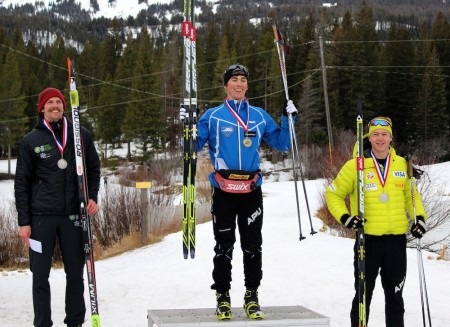
“It caught up to me in the final, I just didn’t have anything left,” Bjornsen said.
Thought he may not have finished like he wanted, out of all the men in the final he was the only one who had been there before on Thursday, and seems an obvious top choice for the Quebec City team.
The rest of decision will be a tougher one, as there was no other overlap in who made the finals between the days to create clear leaders in the rankings. By the rules, ties go to the athlete with the lowest FIS points.
Pat O’Brien, who finished fourth overall in the lunge behind Hanneman, was uncertain as to how selection would play out.
“I definitely hope things go my way,” he said. “It’s definitely interesting. You have Reid [Pletcher] who won the skate sprint but didn’t make the final today. Ryan [Scott] didn’t even qualify today, so it’s going to be kind of a jumble… But the people who skied the best deserve to go, and I was happy to do better today.”
Of Note:
— Like the women, the men seemed to think the course was fair given the conditions.
“You couldn’t win from the start, so there was a lot of tactics, but that’s sprint racing,” O’Brien said.
“I think they did a great job with what they had and it’s the same course for everybody, so it was fair,” Bjornsen added. “I think the conditions were pretty good, considering.”
— With a few exceptions, the entire field’s collective decision to ski on skate equipment was cemented once coaches saw most of the top men leaving the gate to double pole up the hill. A few athletes, like Bjornsen, wanted to prove everyone wrong by striding, but on Saturday the coach’s word was law.
“A minute before my start [Flora] handed me the skate skis,” Bjornsen said. “I saw everybody with skate skis and I kind of wanted to just go with the classic and prove some people wrong, but he was like, “Go with the skate skis, everybody else is doing it.’”
For Packer, it was more of an obvious choice.
“After racing in Canmore, where we did the Frozen Thunder race, [Andy] Newell showed that on a course with much bigger hills than this double poling was much faster. When we came here this morning, conditions weren’t firm enough on the hill and there was no way classic skiing was going to be competitive,” Packer said. “I think most guys realized that off the bat and decided to double pole.”
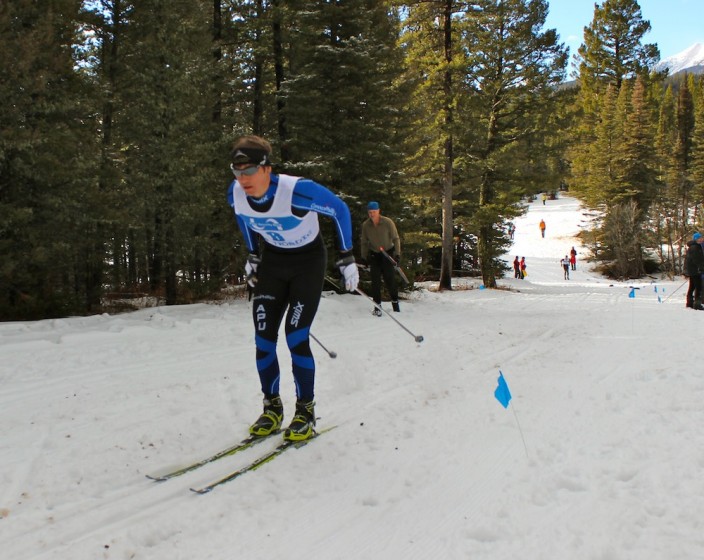
Audrey Mangan
Audrey Mangan (@audreymangan) is an Associate Editor at FasterSkier and lives in Colorado. She learned to love skiing at home in Western New York.



